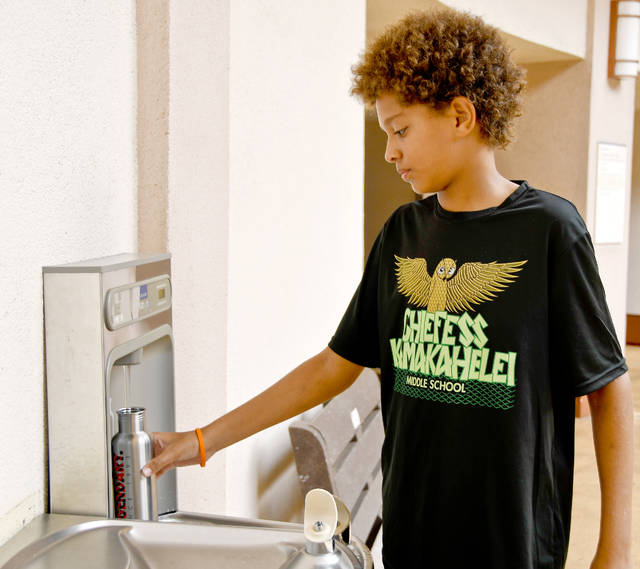LIHUE — Water bottle filling stations are on their way to Kokee, Haena and Wailua, thanks to a grant from the National Oceanic and Atmospheric Administration’s Marine Debris program, but it’s going to take some time for them to land.
The first two are set for the latter half of 2019 in Wailua River State Park, one at the marina building and one at the Opaekaa Falls lookout comfort station.
Haena’s filling station will be installed in 2019 in a project separate from the current construction at the state park set to be completed at the same time as the park’s reopening. The Kokee filling station will be installed in 2020.
When Bikes on Rice’s Tommy Noyes heard about the new filling stations, he and fellow cyclist Jim Benkert said it’s a step in the right direction, but Kauai could use more.
“It’s good to have it in the parks, but (it would be) more effective in the airport because a lot more people use the airport,” Benkert said.
Noyes pointed out many people have to toss their water bottles before going through the TSA checkpoint and then end up spending money to buy another plastic water bottle once they’re in the terminal.
Carl Berg of Surfrider Kauai said the chapter strongly supports the filling stations in state parks on Kauai, and has suggestions for more places that could have them installed — Kauai Community College and more county facilities for starters.
“Hopefully this will decrease the amount of single-use plastic bottles that end up in the ocean, even though there is a successful HI5 recycling program,” Berg said. “We all need to voluntarily stop purchasing and using single-use plastics, like straws, bottles and clam shell food containers.”
While traditional water fountains do supply water, the state Deparment of Land and Natural Resources Division of State Parks is opting for filling stations because the design allows for easier water flow — and there’s water fountains incorporated into the design as well.
Currently, a station is at Diamond Head on Oahu.
Wailua State Park is hosting the first of 19 total filling stations statewide in order to see just how much of an impact these stations can have on things like recycling.
“The station to be installed in the marina building will have a counter that keeps track of how many 20-ounce bottles have been kept out the landfill through the use of the filling station,” said Martha Yent, with DLNR’s Division of State Parks.
Yent continued: “This will assist state parks and NOAA in evaluating the success of these stations in meeting the project goal of reducing the use of single-use plastic bottles.”
The project will see installation of water bottle filling stations in 15 parks in phase one. After that, the vision is to add more as the entity repairs, renovates and constructs park facilities.
“The choice of parks for this initial phase was based on existing waterlines to connect to the stations, the need to replace non-working water fountains, and proximity to hiking trails and high-use visitor areas where park users are likely to need water,” Yent said.
The station at Kokee is more complex because there is no existing water fountain.
“This installation will involve additional planning and design to connection to existing waterlines and insure the station meets all the accessibility requirements of the Americans with Disability Act,” Yent said. “For these reasons, the station at Kokee is scheduled for installation in 2020.”
As for vandalism potential, that’s something state parks says is something that’s always a concern because of their “outdoor setting.”
“There are no special precautions that can be taken,” Yent said. “State parks will order replacement parts to be able to repair the stations quickly if they are damaged or broken.”
•••
Jessica Else, environment reporter, can be reached at 245-0452 or jelse@thegardenisland.com.


